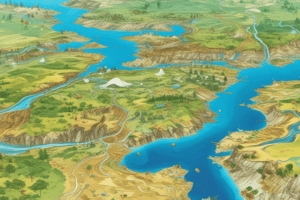Podcast
Questions and Answers
What is remote sensing primarily used for?
What is remote sensing primarily used for?
- Creating physical models of landscapes
- Only mapping urban areas
- Acquisition of information without physical contact (correct)
- Obtaining physical measurements from objects
Active remote sensing systems detect naturally emitted radiation.
Active remote sensing systems detect naturally emitted radiation.
False (B)
Name two platforms from which remote sensing data can be acquired.
Name two platforms from which remote sensing data can be acquired.
Satellites and drones
GIS combines spatial data with ______ data.
GIS combines spatial data with ______ data.
Match the following types of remote sensing with their descriptions:
Match the following types of remote sensing with their descriptions:
What is one benefit of remote sensing?
What is one benefit of remote sensing?
GIS software can only handle raster data types.
GIS software can only handle raster data types.
What are two outputs that can result from integrating remote sensing with GIS?
What are two outputs that can result from integrating remote sensing with GIS?
The primary purpose of integrating remote sensing and GIS is to achieve a more ______ understanding of geographic phenomena.
The primary purpose of integrating remote sensing and GIS is to achieve a more ______ understanding of geographic phenomena.
Which electromagnetic wavelength is NOT commonly used in remote sensing?
Which electromagnetic wavelength is NOT commonly used in remote sensing?
Flashcards
What is remote sensing?
What is remote sensing?
The process of gathering information about objects or phenomena without direct contact, using electromagnetic radiation.
What are some applications of remote sensing data?
What are some applications of remote sensing data?
Data obtained from remote sensing can be used to create maps, analyze landscapes, and monitor environmental changes.
What are different types of electromagnetic radiation used in remote sensing?
What are different types of electromagnetic radiation used in remote sensing?
Remote sensing uses different wavelengths of electromagnetic radiation to provide information about the object or phenomenon being studied. For example, visible light, infrared, and microwave radiation.
Can you explain the difference between active and passive remote sensing?
Can you explain the difference between active and passive remote sensing?
Signup and view all the flashcards
What is Geographic Information Systems (GIS)?
What is Geographic Information Systems (GIS)?
Signup and view all the flashcards
What is the purpose of combining spatial and attribute data in GIS?
What is the purpose of combining spatial and attribute data in GIS?
Signup and view all the flashcards
How is spatial data represented in GIS?
How is spatial data represented in GIS?
Signup and view all the flashcards
What are some capabilities of GIS tools for analyzing spatial data?
What are some capabilities of GIS tools for analyzing spatial data?
Signup and view all the flashcards
Why is integrating remote sensing and GIS beneficial?
Why is integrating remote sensing and GIS beneficial?
Signup and view all the flashcards
How do remote sensing and GIS work together for analysis?
How do remote sensing and GIS work together for analysis?
Signup and view all the flashcards
Study Notes
Remote Sensing
- Remote sensing is the acquisition of information about an object or phenomenon without physical contact.
- It measures electromagnetic radiation reflected or emitted from the object.
- Remote sensing data creates maps, analyzes landscapes, and monitors environmental changes.
- Data acquisition platforms include satellites, aircraft, and drones.
- Different electromagnetic wavelengths (e.g., visible light, infrared, microwave) provide varying information.
- Passive remote sensing detects naturally emitted radiation; active remote sensing emits radiation and detects the reflected portion.
- Benefits include wide area coverage and accessibility over time.
Geographic Information Systems (GIS)
- GIS is a computer system for capturing, storing, checking, integrating, manipulating, analyzing, and displaying location-based data.
- It combines spatial data (location) with attribute data (associated information).
- GIS software overlays datasets to visualize relationships and patterns.
- Key components are hardware (computers, software), data (spatial and attribute), and human expertise (analysts, users).
- Data sources include remote sensing imagery, maps, surveys, and databases.
- Spatial data representations include points, lines, polygons, and raster grids.
- GIS enables sophisticated spatial analysis techniques.
Remote Sensing and GIS Integration
- Integrating remote sensing and GIS allows for comprehensive geographic analysis.
- Remote sensing provides high-resolution images and data for ground features.
- GIS processes, analyzes, and visualizes remote sensing data.
- Combined data enables quantitative and qualitative spatial analysis.
- Applications include land cover classification, change detection, soil mapping, and urban planning.
- Remote sensing data creates basemaps and vectorizes GIS features.
- GIS creates thematic maps, visualizes spatial patterns, and performs spatial analysis on remote sensing data.
- GIS uses remote sensing imagery for insights into environmental issues, urban growth, natural hazards, and land use change.
- GIS helps understand factors driving changes observed in remote sensing data.
- Workflow involves data acquisition, pre-processing (e.g., image corrections), analysis, visualization, and reporting.
- Outputs include maps, charts, and reports for clear results presentation.
- Accuracy relies on data quality and analysis methods.
- Integration provides a more comprehensive understanding of geographic phenomena.
- This synergy offers greater insight than either technology alone.
Studying That Suits You
Use AI to generate personalized quizzes and flashcards to suit your learning preferences.




